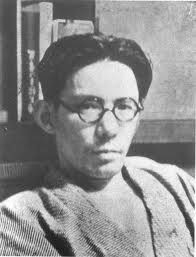Mushitarō Oguri
- View a machine-translated version of the Japanese article.
- Machine translation, like DeepL or Google Translate, is a useful starting point for translations, but translators must revise errors as necessary and confirm that the translation is accurate, rather than simply copy-pasting machine-translated text into the English Wikipedia.
- Do not translate text that appears unreliable or low-quality. If possible, verify the text with references provided in the foreign-language article.
- You must provide copyright attribution in the edit summary accompanying your translation by providing an interlanguage link to the source of your translation. A model attribution edit summary is
Content in this edit is translated from the existing Japanese Wikipedia article at [[:ja:小栗虫太郎]]; see its history for attribution. - You may also add the template
{{Translated|ja|小栗虫太郎}}to the talk page. - For more guidance, see Wikipedia:Translation.
Mushitarō Oguri | |
|---|---|
 Mushitarō Oguri. | |
| Born | Eijirō Oguri (1901-03-14)14 March 1901 Kanda, Tokyo, Japan |
| Died | 10 February 1946(1946-02-10) (aged 44) Chiyoda, Tokyo, Japan |
| Occupation | Author |
| Genre | Detective stories |
| Notable works | Black Death Hall Murders Perfect Crime |
Mushitarō Oguri (小栗 虫太郎, Oguri Mushitarō, March 14, 1901 – February 10, 1946), born Eijirō Oguri, was a Japanese author and an important mystery novelist in pre-war Japan.[1]
Biography
Oguri was born in Kanda, Tokyo. His father died in 1911, and the family managed to support themselves financially thanks to the support of the main family branch and the income from renting a house.
In September 1922, Oguri began working at a printing press. During this period, he took interest in literature, and during the four years he worked there, he wrote a series of detective novels and stories: Aru Kenji no Isho, Gen'naiyaki Rokuju Kazuhisa, Benigara Rakuda no Himitsu and Madōji. These last three works would later be published in 1936 (Aru Kenji no Isho was published in 1927).

Major works
Oguri's major works include:
- Black Death Hall Murders (Kokushikan Satsujinjiken, 黒死館殺人事件)
- Perfect Crime (Kanzen Hanzai, 完全犯罪)
According to researcher Sari Kawana, he was one of the authors involved in writing "mad scientist murders," a subgenre within the larger stream of Japanese detective fiction during the 1920s and 1930s. He used the motif of the "mad scientist" and his uncompromising attitude toward his work to criticize the widespread overconfidence in the possibilities of science and to highlight the potential incompatibility between science and ethics. Other writers involved in that genre were Kozakai Fuboku, Yumeno Kyusaku, and Unno Juza.[2]
See also
- Japanese literature,
- List of Japanese authors
Notes

- v
- t
- e










